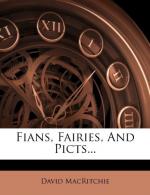“The Pict’s house on the Holm of Papay [Orkney] would have held, besides the chiefs at each end, all the families in [the island of] Papay Westray when it was built. Maes howe[67] was for three families—grandees, no doubt; but the numbers it was intended to hold in the beds may be learned by comparing them with the Amazon’s House, St. Kilda."[68]
“I consider the relation between the boths [beehive houses] and the Picts’ houses of the Orkneys (and elsewhere) to be evident—the same method of forming the arch, the low and narrow doors and passages, the enormous thickness of the walls, when compared with the interior accommodation—exist in both. When a both is covered with green turf it becomes a chambered tumulus, and when buried by drifting sand it is a subterranean Pict’s house.... I regard the comparatively large Picts’ houses of the Orkneys as the pastoral residence of the Pictish lord, fitted to contain his numerous family and dependents. Such an one exists on the Holm of Papa Westray, which, according to the Highland method of stowage, would certainly contain a whole clan. When writing the description of it, I had not made acquaintance with a people who would close the door to keep in the smoke, or that nested in holes in a wall like sand-martins....
“But the both of the Long Island is only the lodging of the common man or ‘Tuathanach,’ and is consequently of small dimensions, and not remarkable for comfort. If the modern Highland proprietor or large farmer should ever be induced to lead a pastoral life, and adopt a Pictish architecture in his residence, we might again see a tumulus of twenty feet in height, with its long low passage leading into a large hall with beehive cells on both sides."[69]
But the point of all this is that these dwellings, whether above ground or below, are known as Picts’ Houses, Fairy Halls, Elf Hillocks, “the hidden places of Fians and Fairies.” Thus, the three titles which I have shown to be associated in other ways are all given to the alleged builders and occupiers of those very archaic and peculiar structures.
It is true that, in their most modern form, some of those dwellings are still inhabited for months at a time. And their inhabitants are neither Fians, Fairies nor Picts. But it is among those people that stories of Fians and Fairies are most rife, and many claim an actual descent from them. And although they are certainly not pigmies, yet they live in a district in which the small type of this heterogeneous nation of ours is still quite discernible; and that part of the island of Lewis (Uig), which has longest retained those places as dwellings, is inhabited by a caste whom other Hebrideans describe as small, and regard as different from themselves.[70] Dr. Beddoe states that the tallest people in the United Kingdom are to be found in a certain village in Galloway, where




